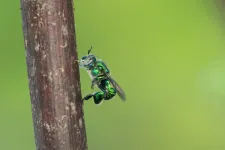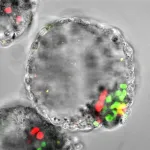(Press-News.org) Male bees display a remarkable passion for collecting scents: they deposit scents from various sources in special pockets on their hind legs, thus composing their own fragrance. This behaviour has been known since the 1960s. The reason why they do it has been the subject of much speculation just as long. Researchers from Ruhr University Bochum, Germany, in collaboration with colleagues from the University of California at Davis and the University of Florida at Fort Lauderdale, have finally solved the mystery. The bee fragrance serves as a sex attractant and increases the reproductive success of the males, as the team found out after three years of experiments in flight cages. The group headed by PhD student Jonas Henske and Dr. Thomas Eltz from the Bochum Department of Animal Ecology, Evolution and Biodiversity describes their findings in the journal “Current Biology”, published online on 12 April 2023.
There’s been a lot of theorising about the purpose of the fragrance: some have suggested that it could be an attractant or a wedding gift for the females, or that the scent is used to communicate with rivals. In a previous paper, the group around Thomas Eltz had already shown that the male bees transport the fragrance out of the pockets on their hind legs during the courtship ritual. “What we didn’t know, however, was who was supposed to receive this signal,” says Eltz. “The females? Or rival males?”
The researchers pursued this question in the current project. For three years, they studied orchid bees in an experiment in Florida. In a 15 by 15 by 4 metre cage, they had two male bees each compete for a female – one with fragrance and one without. They then tracked whether the female mated and, if so, with which male.
Mating activities difficult to observe
“The mating of orchid bees is very rarely observed in the wild, and even in experiments it’s been almost impossible to get them to mate,” as Thomas Eltz describes the challenge. This is why the Bochum-based researchers and their US colleagues tried to offer the bees optimal conditions; for example, they used a particularly large cage and provided the animals with the perfect pollen plants.
For the experiment, the researchers first lured male bees to artificial scent sources, which the bees then used to create a fragrance. The scientists extracted this fragrance from the pockets on the hind legs using a microcapillary and subsequently transferred it to one of the bees that they tested in the experiment. Here, two males, which had been kept under identical conditions, competed for the favour of females.
Typical courtship behaviour with varying degrees of success
The males – with or without fragrance – displayed typical courtship behaviour. Mating occurred with 27 females, which each mated with a single mate. Male bees that had been equipped with fragrance were involved in 26 of these cases. In one case, a male reproduced that belonged to the control group, which should have been fragrance-free; however, the researchers found hints that this individual had also acquired a scent mixture – fragrance theft does occasionally occur.
In order to be able to prove beyond doubt which males had mated, Jonas Henske carried out paternity analyses. He compared the genetic make-up of the brood with that of the male bees.
“It’s become clear that the fragrance is an attractant for females and triggers mating behaviour in them,” as Thomas Eltz sums up the findings. “Our results also prove that the fragrance is probably not used as a status signal among males. Indeed, a male was not more likely to defend his courtship site when he was in possession of fragrance.”
About orchid bees
There are about 250 known species of euglossine bees that are important pollinators in the tropics of Central and South America. Many orchid species rely on male euglossine bees for pollination, which is why these insects are commonly known as orchid bees. These orchids produce specific flower scents as a reward, which are collected by the male bees. There are five different genera of orchid bees, and they can vary greatly in size and appearance. The male bees collect the scents with tufts of hair on their front legs, which they wring out into the pockets on their hind legs.
END
Why orchid bees concoct their own fragrance
2023-04-13
ELSE PRESS RELEASES FROM THIS DATE:
Uncovering hidden mitochondrial mutations in single cells
2023-04-13
A high-throughput single-cell single-mitochondrial genome sequencing technology known as iMiGseq has provided new insights into mutations of mitochondrial DNA (mtDNA) and offers a platform for assessing mtDNA editing strategies and genetic diagnosis of embryos prior to their implantation.
An international team of researchers, led by KAUST stem cell biologist Mo Li, has now quantitatively depicted the genetic maps of mtDNA in single human oocytes (immature eggs) and blastoids (stem cell-based synthetic embryos)[1]. This has revealed molecular features of rare mtDNA mutations that cause maternally inherited diseases.
Mitochondria, the ...
Effectiveness of COVID-19 mRNA vaccination for children and adolescents confirmed by multi-state study
2023-04-13
A multi-state study from the Centers for Disease Control and Prevention’s (CDC’s) VISION Network confirms that the Pfizer-BioNTech mRNA COVID-19 vaccine has provided children and adolescents, ages 5-17, with protection against both moderate and severe COVID-19 outcomes.
The study found that for 12-17 year olds, vaccine effectiveness was high against the Delta variant but lower during Omicron dominance, including BA.4 and BA.5. Due to the youngest age (5-11) group’s ineligibility for vaccination during Delta predominance, vaccine effectiveness could be estimated for these children only during the Omicron predominant ...
Four early-career cancer researchers earn prestigious annual award from NCCN Foundation
2023-04-13
PLYMOUTH MEETING, PA [April 13, 2023] — The National Comprehensive Cancer Network® (NCCN®) and the NCCN Foundation® today announced four winners for the 2023 NCCN Foundation Young Investigator Awards. These annual awards honor up-and-coming leaders in oncology research working to investigate and advance cancer care. The honorees will each receive up to $150,000 in funding for projects that will run over two years. The selection process is overseen by the NCCN Oncology Research Program (ORP) which will also provide oversight.
“It is a privilege to support these emerging innovators ...
Some people may be attracted to others over minimal similarities
2023-04-13
We are often attracted to others with whom we share an interest, but that attraction may be based on an erroneous belief that such shared interests reflect a deeper and more fundamental similarity—we share an essence—according to research published by the American Psychological Association.
“Our attraction to people who share our attributes is aided by the belief that those shared attributes are driven by something deep within us: one’s essence,” said lead author Charles Chu, PhD, an assistant professor at the Boston University Questrom School of Business. “To put it concretely, we like someone who agrees with us on a political issue, shares our music ...
The Biophysical Journal launches Postdoctoral Reviewer Program
2023-04-13
Today the Biophysical Journal is launching a new initiative, the Postdoctoral Reviewer Program. The program provides postdoctoral researchers in biophysics the opportunity to partner with Associate Editors and complete reviews that will be used in deciding whether articles will be accepted for publication.
Candidates for this program must be in a postdoctoral position during the 2023–2024 academic year and a member of BPS in good standing. Applications for the new program will be accepted through July 1 for a single-year term beginning in September 2023. Interested candidates can find more information about the program and application process online.
“I am extremely ...
Scientists create high-efficiency sustainable solar cells for IoT devices with AI-powered energy management
2023-04-13
Newcastle University researchers have created environmentally-friendly, high-efficiency photovoltaic cells that harness ambient light to power internet of Things (IoT) devices.
Led by Dr Marina Freitag, the research group from the from School of Natural and Environmental Sciences (SNES) created dye-sensitized photovoltaic cells based on a copper(II/I) electrolyte, achieving an unprecedented power conversion efficiency of 38% and 1.0V open-circuit voltage at 1,000 lux (fluorescent lamp). The cells are non-toxic and environmentally friendly, setting a new standard for sustainable ...
A sharper look at the M87 black hole
2023-04-13
The iconic image of the supermassive black hole at the center of M87—sometimes referred to as the “fuzzy, orange donut”—has gotten its first official makeover with the help of machine learning. The new image further exposes a central region that is larger and darker, surrounded by the bright accreting gas shaped like a “skinny donut.” The team used the data obtained by the Event Horizon Telescope (EHT) collaboration in 2017 and achieved, for the first time, the full resolution of the array.
In 2017, the EHT collaboration used a network of seven pre-existing telescopes ...
Gentle method allows for eco-friendly recycling of solar cells
2023-04-13
By using a new method, precious metals can be efficiently recovered from thin-film solar cells. This is shown by new research from Chalmers University of Technology, Sweden. The method is also more environmentally friendly than previous methods of recycling and paves the way for more flexible and highly efficient solar cells.
Today there are two mainstream types of solar cells. The most common is silicon-based and accounts for 90 percent of the market. The other type is called thin-film solar cells which in turn uses three main sub-technologies, one of which is known as CIGS ...
Infant formulas promise too much
2023-04-13
Many infant formulas promise a lot. Several products claim that they help develop the brain, increase immunity and promote children's growth and development, among other things.
Now a research group led by Imperial College London has looked at whether these promises have any substance to them. The article has recently been published in BMJ.
“Most of the claims about the health-giving and nutritional properties of breast milk substitutes seem to be based on little or no evidence,” the research group says.
Claims surrounding these replacement milk products are controversial. They can give the impression ...
CESJ selected for the ERC grant to launch a European program of science journalists in residence
2023-04-13
Milan (Italy), 13 April 2023 – The Center for Ethics in Science and Science Journalism (CESJ, www.cesj.eu) is among the partners of the FRONTIERS consortium that was selected by the European Research Council for a grant of 1.5 million euro to establish a residency program for science journalists in research institutions across Europe, and measure its impact on the lifelong professional development of science journalism in Europe. The consortium also includes the NOVA University of Lisbon (Portugal), ...







